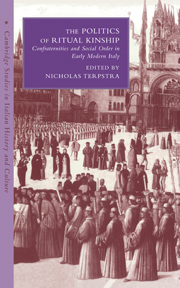Book contents
- Frontmatter
- Contents
- List of Contributors
- Acknowledgments
- Introduction The Politics of Ritual Kinship
- 1 The development of confraternity studies over the past thirty years
- 2 Homosociality and civic (dis)order in late medieval Italian confraternities
- 3 Confraternities and lay female religiosity in late medieval and Renaissance Umbria
- 4 The bounds of community: commune, parish, confraternity, and charity at the dawn of a new era in Cortona
- 5 Men and women in Roman confraternities in the fifteenth and sixteenth centuries: roles, functions, expectations
- 6 The Medici and the youth Confraternity of the Purification of the Virgin, 1434–1506
- 7 In loco parentis: confraternities and abandoned children in Florence and Bologna
- 8 The first Jesuit confraternities and marginalized groups in sixteenth-century Rome
- 9 Jewish confraternal piety in sixteenth-century Ferrara: continuity and change
- 10 The scuole piccole of Venice: formations and transformations
- 11 Relaunching confraternities in the Tridentine era: shaping conscience and Christianizing society in Milan and Lombardy
- 12 The development of Jesuit confraternity activity in the Kingdom of Naples in the sixteenth and seventeenth centuries
- 13 Corpus Domini: ritual metamorphoses and social changes in sixteenth- and seventeenth-century Genoa
- 14 Faith's boundaries: ritual and territory in rural Piedmont in the early modern period
- 15 The suppression of confraternities in Enlightenment Florence
- Bibliography
- Index
- CAMBRIDGE STUDIES IN ITALIAN HISTORY AND CULTURE
5 - Men and women in Roman confraternities in the fifteenth and sixteenth centuries: roles, functions, expectations
Published online by Cambridge University Press: 02 October 2009
- Frontmatter
- Contents
- List of Contributors
- Acknowledgments
- Introduction The Politics of Ritual Kinship
- 1 The development of confraternity studies over the past thirty years
- 2 Homosociality and civic (dis)order in late medieval Italian confraternities
- 3 Confraternities and lay female religiosity in late medieval and Renaissance Umbria
- 4 The bounds of community: commune, parish, confraternity, and charity at the dawn of a new era in Cortona
- 5 Men and women in Roman confraternities in the fifteenth and sixteenth centuries: roles, functions, expectations
- 6 The Medici and the youth Confraternity of the Purification of the Virgin, 1434–1506
- 7 In loco parentis: confraternities and abandoned children in Florence and Bologna
- 8 The first Jesuit confraternities and marginalized groups in sixteenth-century Rome
- 9 Jewish confraternal piety in sixteenth-century Ferrara: continuity and change
- 10 The scuole piccole of Venice: formations and transformations
- 11 Relaunching confraternities in the Tridentine era: shaping conscience and Christianizing society in Milan and Lombardy
- 12 The development of Jesuit confraternity activity in the Kingdom of Naples in the sixteenth and seventeenth centuries
- 13 Corpus Domini: ritual metamorphoses and social changes in sixteenth- and seventeenth-century Genoa
- 14 Faith's boundaries: ritual and territory in rural Piedmont in the early modern period
- 15 The suppression of confraternities in Enlightenment Florence
- Bibliography
- Index
- CAMBRIDGE STUDIES IN ITALIAN HISTORY AND CULTURE
Summary
Men and women joining Rome's Gonfalone confraternity in the late fifteenth century swore a membership oath which expressed the religious attitudes common to a large part of the devout laity. The venerable brotherhood's statutes, revised in 1495, lay out a program of private devotions and collective activities necessary to obtain the soul's salvation. Brothers and sisters had to “perform deeds which were pleasing” to God, to the Virgin Mary, and to the patron saints, in accordance with the instructions laid down by the confraternity's administering bodies regarding two general areas of collective life. First, regarding the economic management of the confraternity, applicants pledged to “procure the honor, use and enhancement of the places, buildings and property of the said company,” and accept the attendant social duties, carry them out conscientiously, and give an account of them at the end of the mandate. Second, regarding devotional practices, members agreed both to participate in public events, marching in processions and attending funerals, memorial services, and anniversaries organized for deceased fellow–members and benefactors, and to offer up private prayers for these defunti on the occasion of their funeral and on the anniversaries of their death.
The “program” which the new member of the Gonfalone confraternity undertook to follow is laid out in great detail in the seventy-four articles of the statutes and resembles those drawn up by other religious lay associations of the time.
- Type
- Chapter
- Information
- The Politics of Ritual KinshipConfraternities and Social Order in Early Modern Italy, pp. 82 - 97Publisher: Cambridge University PressPrint publication year: 1999
- 1
- Cited by



